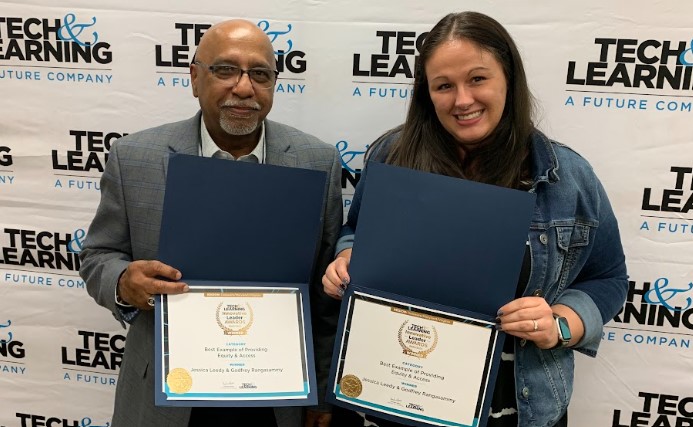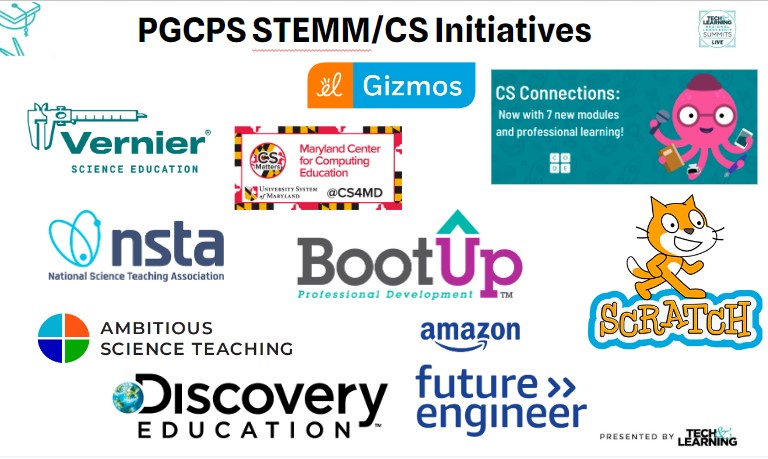
When Maryland adopted the Next Generation Science Standards (NGSS) in 2013, STEM leaders in Prince George's County Public Schools, home to more than 130,000 diverse students, knew it would take a comprehensive effort to make sure that all learners were included.
“I think the whole notion of equity and access from day one should start from pre-K, not middle school, not high school, but pre-K and go through college,” says Dr. Godfrey Rangasammy, K-12 Science Supervisor for the district. Rangasammy and Jessica Leedy, PGCPS high school literacy coach, were recently honored for their work by Tech & Learning with an Innovative Leader Award during the Delaware/Maryland/Virginia Regional Leadership Summit.

Consequently, the district has undergone a decade-long effort to address STEM equity across all grades – pre-K-5, middle, and high school – with Rangasammy spearheading the effort. The focus has been on equitable access to exemplary teachers, science/STEM curriculum programming, and instructional best practices. In addition to making sure content is NGSS-aligned, an additional emphasis has been put on student achievement and career and college readiness.
Building Equity Through NGSS: Being Intentional
Rangasammy points to research that shows Black and Brown preschoolers are marginalized. “When I look at whatever behavior of Black and Brown students, be it suspension rates in middle school, high school, and even in society – it all starts in pre-K,” he says.
Thus, pre-K is the ideal time to start all students down the STEM path. “The excitement is there, especially in the early grades. We get the kids excited and asking questions and talking about science or writing about science. You know, the ‘light bulb going on’ moments.”
The PGCPS STEM equity effort originally started with an internal assessment, and then has focused on improving engagement with new NGSS-aligned textbooks and course materials, phenomena-based learning, hands-on activities, and creating opportunities to connect with those working in STEM fields.
“You really have to bring in the experts in science in the city, so the students can see people of the same race, ethnicity, and so forth, in the district,” says Rangasammy.
Collaboration is also key, says Rangasammy, both with his staff and teachers, as is building capacity. Acknowledging that many teachers may have only had a few basic science courses in their own education, addressing gaps in curriculum and pedagogy through external audits and connecting with experts is critical. Getting everyone involved and invested needs to happen.
“In my office, I keep telling my folks, ‘Change is a concept. Go with it. It's gonna be here and you're here when you leave, it's still gonna be here,’” he says.
And, of course, involving the community is also essential. Since initially there was no science taught until second grade, Rangasammy pushed to start STEM Fridays during summer school that feature fun hands-on activities such as coding and robotics, as well as sending home hands-on manipulatives. “The kids loved it, so the parents loved it,” says Rangasammy. “Also, the focus there was 40% ELD. So that's the marginalized population, and trying to support bringing them up to a level where they could compete with all kids.”

‘No Price on Curiosity’
The district has also embraced phenomena-based learning, and is connecting it to real-world situations, such as studying the nearby Chesapeake Bay ecosystem. For a hands-on learning example, ninth-grade students grow live mussels in tanks in their classrooms, checking and analyzing data on pH, temperature, dissolved oxygen turbidity, and other factors.
The district also encourages participation in its annual science fair, which is in its 76th year now, making it one of the oldest in the nation. They recruit STEM organizations to be involved and provide scholarships. “We’ve had winners who happened to be Black and Brown kids, so we know we can make a difference,” Rangasammy says. “We can challenge the status quo and we can change it but we have to be consistent. So it takes a lot of work. The vision is okay, but you have got to put in the work. Plus, the right people have to be in the right place to want to do the heavy lifting.”
Ultimately, Rangasammy says that NGSS focuses on supporting marginalized populations and meeting kids where they are, from pre-K through 12.
“There's no price on curiosity,” says Rangasammy. “That crosses all socioeconomic groups, right?”







